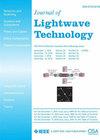优化包层弹性以提高硅光子超声传感器的灵敏度
IF 4.1
1区 工程技术
Q2 ENGINEERING, ELECTRICAL & ELECTRONIC
引用次数: 0
摘要
超声在医学成像中应用广泛,新兴的光声成像技术对疾病诊断具有重要意义。目前,高端的光声成像系统依赖于压电材料来探测超声波,这伴随着灵敏度、噪声和带宽的限制。先进的应用需要大量的宽带、高分辨率和可扩展的超声波传感器。为了满足这些要求,硅光子电路被引入来检测硅波导中超声引起的变形和应力。虽然更高的灵敏度可以促进新应用的探索,但波导材料的高刚度限制了硅光子电路对超声信号的固有灵敏度。本文探讨了聚合物包层的力学性能对硅光子超声传感器灵敏度的影响。我们的模型和实验表明,优化聚合物包层的刚度可以提高共振波长的灵敏度。实验表明,与没有包层聚合物的传感器相比,灵敏度提高了四倍,与具有饱和交联密度的包层聚合物的传感器相比,灵敏度提高了两倍。有趣的是,将实验与光力学模型进行比较表明,杨氏模量的变化不能单独解释灵敏度的增加。总之,聚合物涂层硅光子超声传感器具有先进的光声成像应用潜力。这为采用cmos兼容工艺提高硅光子超声传感器的超声检测灵敏度提供了前景。这为将聚合物涂层硅光子超声传感器与电子器件集成到先进的医学成像应用中铺平了道路。本文章由计算机程序翻译,如有差异,请以英文原文为准。
Optimizing Cladding Elasticity to Enhance Sensitivity in Silicon Photonic Ultrasound Sensors
Ultrasound is widely used in medical imaging, and emerging photo-acoustic imaging is crucial for disease diagnosis. Currently, high-end photo-acoustic imaging systems rely on piezo-electric materials for detecting ultrasound waves, which come with sensitivity, noise, and bandwidth limitations. Advanced applications demand a large matrix of broadband, high-resolution, and scalable ultrasound sensors. Silicon photonic circuits have been introduced to meet these requirements by detecting ultrasound-induced deformation and stress in silicon waveguides. Although higher sensitivities could facilitate the exploration of new applications, the high stiffness of the waveguide materials constrains the intrinsic sensitivity of the silicon photonic circuits to ultrasound signals. Here, we explore the impact of the mechanical properties of a polymer cladding on the sensitivity of silicon photonic ultrasound sensors. Our model and experiments reveal that optimizing the polymer cladding's stiffness enhances the resonance wavelength sensitivity. Experimentally, we show a fourfold increase in the sensitivity compared to the sensors without a cladding polymer and, a twofold sensitivity increase compared to the sensors with a cladding polymer of saturated cross-linking density. Interestingly, comparing experiments with the optomechanical model suggests that the change in Young's Modulus alone cannot explain the sensitivity increase. In conclusion, polymer-coated silicon photonic ultrasound sensors exhibit potential for advanced photo-acoustic imaging applications. It offers the prospect of increasing the ultrasound detection sensitivity of silicon photonic ultrasound sensors while using CMOS-compatible processes. This paves the way to integrate the polymer-coated silicon photonic ultrasound sensors with electronics to utilize the sensors in advanced medical imaging applications.
求助全文
通过发布文献求助,成功后即可免费获取论文全文。
去求助
来源期刊

Journal of Lightwave Technology
工程技术-工程:电子与电气
CiteScore
9.40
自引率
14.90%
发文量
936
审稿时长
3.9 months
期刊介绍:
The Journal of Lightwave Technology is comprised of original contributions, both regular papers and letters, covering work in all aspects of optical guided-wave science, technology, and engineering. Manuscripts are solicited which report original theoretical and/or experimental results which advance the technological base of guided-wave technology. Tutorial and review papers are by invitation only. Topics of interest include the following: fiber and cable technologies, active and passive guided-wave componentry (light sources, detectors, repeaters, switches, fiber sensors, etc.); integrated optics and optoelectronics; and systems, subsystems, new applications and unique field trials. System oriented manuscripts should be concerned with systems which perform a function not previously available, out-perform previously established systems, or represent enhancements in the state of the art in general.
 求助内容:
求助内容: 应助结果提醒方式:
应助结果提醒方式:


